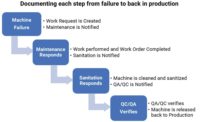In the midst of the ongoing COVID-19 pandemic, snack and bakery companies—many of which have instituted higher levels of production in the wake of increased shopper demands—are reviewing sanitation standard operating procedures (SSOPs).
“The key to any sanitation program in a bakery environment is the master sanitation schedule. The manager needs to be diligent and thorough and ensure all master sanitation items (non-daily sanitation) are performed as scheduled and verified as being completed and acceptable,” recommends Kent Bruns, senior director of food safety, PSSI, Kieler, WI. “This will include overhead structures and deep cleaning of equipment that requires extensive disassembly and cleaning. The Sanitation Manager needs to work hand in hand with the FSQA Manager to ensure the master sanitation schedule program is effective and make changes to the program as warranted.”
Jesus Madera, food safety professional, AIB International, Manhattan, KS, says some of the biggest sanitation issues we see today are also some of the most basic and easily addressed. “In bakeries, we see the improper maintenance and cleaning of overhead pipes and structures, which leads to infestations of cereal insects. In snack plants, there is often a focus on product zone cleaning, while neglecting the rest of the facility. In general, we see a lack of proper training, including qualified and certified food safety managers.”
Jeff Gatto, senior manufacturing project engineer, Hixson Architecture & Engineering, Cincinnati, says that dust is one of the major sanitation challenges snack and bakery facilities need to control and manage. “Facilities must be able to contain, capture, clean and dispose of dust. Engineering controls should be designed into the process equipment to contain and capture dust, while facility design promotes proper cleaning and disposal of dust. Current codes require Dust Hazard Analyses to be performed to ensure engineering controls are in place to mitigate hazards and safeguard personnel. Good housekeeping procedures should be followed to eliminate or mitigate fugitive dust. Other benefits of dust control include the reduction of allergen spread and compliance with food safety plans,” he adds.
Another sanitation issue that Hixson sees is the management and cleaning of cooking oil. “Keeping these production lines clean requires facilities to put in place the means and methods to clean all components including fryers, roasters, and exhaust hoods and ductwork,” Gatto notes.
Evan Reyes, director of sales, sanitation division, Goodway Technologies, Stamford, CT, says that there has definitely been an increased emphasis on cleaning environmental surfaces. “It’s an area that hasn’t been a big focus for snack and bakery facilities, but changes in legislation over recent years requires more environmental monitoring. Instead of conducting swabs in only food-contact areas, they need to do micro swabs all over the plant. This is leading to a strong need for improved sanitation on non-food contact surfaces and outside of just the production lines,” he says.
Consumers have an increased interest in packaged foods since they are staying at home, creating greater demand on production facilities, Reyes notes. “As these facilities try to keep up with demand and extend production, it is a challenge to balance an increase in output with the necessary downtime to properly clean and sanitize the entire plant. They are trying to get the same sanitation results in a lot less time. These plants are also facing a lot of pressure to stay price competitive and reduce labor costs. Not only is there an increase in sanitation standards through legislation, but COVID-19 has heightened awareness of food safety and customers are expecting an increase in both food safety and product quality.”
The culmination of all these factors is creating a challenge for sanitation professionals and, Reyes is working with them to make sure they have the best solutions to quickly and effectively clean and sanitize both food-contact and non-food contact surfaces, says Reyes. “And it’s more than getting them the right equipment, but partnering together to incorporate best practices into their sanitation process and drive improvement.”
Company: Goodway Technologies
Website: www.goodway.com
Sanitation Snapshot: “You always want to start with what is the goal of sanitation for your facility. Identifying the goal and objectives will help to customize a process that is effective for you. Is it cleaning and sanitizing to produce safe food, or is there an allergen level of cleanliness that needs to be considered? There could be specific microorganisms of concern within the plant that requires cleaning to a micro level to ensure there is no contamination in the product,” says Reyes.
It’s also key to look at critical control points and what that means for food safety and quality.
“For example, an oven in a bakery—we know that any microorganisms are going to be killed from high temperatures in the oven, so we take a look at the environment before the oven and after the oven and how that impacts the type of cleaning that should be conducted, says Reyes.
Equipment design is also a factor that should be considered, whether it’s easy to clean or it would require disassembly to thoroughly clean and sanitize, Reyes notes. “Facility design plays a big part as well. Is it a modern facility with a hygienically designed infrastructure? There is also pest control risk. We have to worry about flower beetles in a bakery. Each facility will have their own insect or rodent concerns and it may be different plant to plant. There are a lot of variables when developing a SSOP, from reviewing the goals and objectives to evaluating the risk profile of the product. It’s not as cut and dry as you may think, every plant is unique when creating a sanitation program,” he says.
Other SSOP recommendations include:
-
Do surface swabs of equipment
-
Finished product testing
-
Visual inspection performed by QA/QC staff
-
Develop a COVID-19 response plan in case of outbreak
Company: Hixson Architecture & Engineering
Website: www.hixson-inc.com
Sanitation Snapshot: Gatto says that the top factor to consider is the diversity of the cross-functional team writing the SSOPs. “This team should include members from Engineering, Production, Sanitation, Quality and Safety,” he notes.
Best practices Hixson has observed include a continuous improvement mindset and a regular “plan, do, check, act (PDCA) cycle,” involving a cross-functional team comprised of members representing engineering, production, sanitation, quality, and safety, Gatto adds. “SSOPs should be reviewed whenever a manufacturing process is modified or ingredients are changed, in particular when introducing allergens, organic/non-organic, or GMO/non-GMO components. In addition, SSOPs should be reviewed whenever a facility modification takes place, in particular when room modifications or HVAC changes will impact temperature control and air balance,” he says.
Other SSOP recommendations include:
-
Ensure safe and ergonomic access to hard-to-reach places
-
Separate rooms based on wet or dry cleanup methods
-
Design piping, tanks and kettles to be cleaned using Clean In Place (CIP) methods
-
Specify equipment to comply with sanitary guidelines
-
Provide portable or central vacuum systems for dry cleanup
Company: AIB International
Website: www.aibinternational.com/en/
Sanitation Snapshot: In developing SSOPs, many snack and bakery facilities are focused on reducing the workforce available to carry out these important tasks, says Madera. “Most facilities know the time standards, equipment amounts, and how many hours SSOPs require to maintain existing equipment and still, the focus is on reducing their workforce. That makes the effective implementation of SSOPs nearly impossible,” he says.
When monitoring the effectiveness of SSOPs, manufacturers should focus on the quality of the work, rather than efficiency, Madera recommends. “By focusing on quality, rather than the speed of getting the job done, SSOPs can help ensure that food safety is the manufacturer’s priority.”
Facilities should review their SSOPs once per year, when changes to the production process or the facility structure occur, or when there are changes in legislation that impact production, says Madera. “By having these reviews in place, facility management can ensure their SSOPs are continuously reflective of changes in their facility and the operating environment.”
Other SSOP recommendations include:
-
Focus on quality of work, rather than efficiency
-
Have qualified and certified food safety managers
-
Don’t reduce workforce







